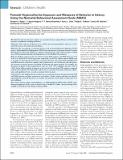| dc.contributor.author | Sagiv, Sharon | |
| dc.contributor.author | Nugent, J. Kevin | |
| dc.contributor.author | Brazelton, Thomas Berry | |
| dc.contributor.author | Choi, Anna Lai | |
| dc.contributor.author | Tolbert, Paige E. | |
| dc.contributor.author | Altshul, Larisa M. | |
| dc.contributor.author | Korrick, Susan Abigail | |
| dc.date.accessioned | 2011-05-19T19:46:18Z | |
| dc.date.issued | 2008 | |
| dc.identifier.citation | Sagiv, Sharon K., J. Kevin Nugent, T. Berry Brazelton, Anna L. Choi, Paige E. Tolbert, Larisa M. Altshul, and Susan A. Korrick. 2008. Prenatal Organochlorine Exposure and Measures of Behavior in Infancy Using the Neonatal Behavioral Assessment Scale (NBAS). Environmental Health Perspectives 116(5): 666-673. | en_US |
| dc.identifier.issn | 0091-6765 | en_US |
| dc.identifier.uri | http://nrs.harvard.edu/urn-3:HUL.InstRepos:4892214 | |
| dc.description.abstract | Background: Previous literature suggests an association between organochlorines and behavioral measures in childhood, including inattention. Objective: This study was designed to assess whether prenatal organochlorine exposure is associated with measures of attention in early infancy. Methods: We investigated an association between cord serum polychlorinated biphenyls (PCBs) and p,p′-dichlorodiphenyl dichloroethene (DDE) levels and measures of attention from the Neonatal Behavioral Assessment Scale (NBAS) in a cohort of 788 infants born 1993–1998 to mothers residing near a PCB-contaminated harbor and Superfund site in New Bedford, Massachusetts. Results: Medians (ranges) for the sum of four prevalent PCB congeners and DDE levels were 0.19 (0.01–4.41) and 0.30 (0–10.29) ng/g serum, respectively. For the 542 subjects with an NBAS exam at 2 weeks, we observed consistent inverse associations between cord serum PCB and DDE levels and NBAS measures of alertness, quality of alert responsiveness, cost of attention, and other potential attention-associated measures including self-quieting and motor maturity. For example, the decrement in quality of alert responsiveness score was −0.51 (95% confidence interval, −0.99 to −0.03) for the highest quartile of exposure to the sum of four prevalent PCB congeners compared with the lowest quartile. We found little evidence for an association with infant orientation, habituation, and regulation of state, assessed as summary cluster measures. Conclusions: Our findings provide evidence for an association between low-level prenatal PCB and DDE exposures and poor attention in early infancy. Further analyses will focus on whether organochlorine-associated decrements in attention and attention-related skills in infancy persist in later childhood. | en_US |
| dc.language.iso | en_US | en_US |
| dc.publisher | National Institute of Environmental Health Sciences | en_US |
| dc.relation.isversionof | doi:10.1289/ehp.10553 | en_US |
| dc.relation.hasversion | http://www.ncbi.nlm.nih.gov/pmc/articles/PMC2367684/pdf/ | en_US |
| dash.license | LAA | |
| dc.subject | behavior | en_US |
| dc.subject | infant | en_US |
| dc.subject | organochlorines | en_US |
| dc.subject | p,p´-dichlorodiphenyl dichloroethene (DDE) | en_US |
| dc.subject | polychlorinated biphenyls (PCBs) | en_US |
| dc.subject | children's health | en_US |
| dc.title | Prenatal Organochlorine Exposure and Measures of Behavior in Infancy Using the Neonatal Behavioral Assessment Scale (NBAS) | en_US |
| dc.type | Journal Article | en_US |
| dc.description.version | Version of Record | en_US |
| dc.relation.journal | Environmental Health Perspectives | en_US |
| dash.depositing.author | Korrick, Susan Abigail | |
| dc.date.available | 2011-05-19T19:46:18Z | |
| dash.affiliation.other | HMS^Medicine-Brigham and Women's Hospital | en_US |
| dash.affiliation.other | HMS^Emeritus | en_US |
| dash.affiliation.other | HMS^Medicine-Brigham and Women's Hospital | en_US |
| dash.affiliation.other | SPH^Environmental+Occupational Medicine+Epi | en_US |
| dc.identifier.doi | 10.1289/ehp.10553 | * |
| dash.contributor.affiliated | Brazelton, Thomas | |
| dash.contributor.affiliated | Korrick, Susan | |
| dash.contributor.affiliated | Choi, Anna Lai | |
| dash.contributor.affiliated | Altshul, Larisa | |
| dash.contributor.affiliated | Nugent, J.K. | |


